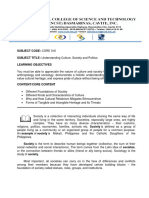0% found this document useful (0 votes)
17 views3 pagesModule - Week 2 UCSP
The document provides an overview of culture, society, and politics, defining culture as the shared beliefs, behaviors, and material objects of a society, and distinguishing between material and non-material culture. It discusses the components of culture, the classification of norms, and the differences between culture and society, while also exploring cultural change, subcultures, and social groups. Additionally, it outlines various types of social groups and organizations, emphasizing their roles, structures, and the importance of norms and sanctions within these entities.
Uploaded by
aclcmercadoCopyright
© © All Rights Reserved
We take content rights seriously. If you suspect this is your content, claim it here.
Available Formats
Download as PDF, TXT or read online on Scribd
0% found this document useful (0 votes)
17 views3 pagesModule - Week 2 UCSP
The document provides an overview of culture, society, and politics, defining culture as the shared beliefs, behaviors, and material objects of a society, and distinguishing between material and non-material culture. It discusses the components of culture, the classification of norms, and the differences between culture and society, while also exploring cultural change, subcultures, and social groups. Additionally, it outlines various types of social groups and organizations, emphasizing their roles, structures, and the importance of norms and sanctions within these entities.
Uploaded by
aclcmercadoCopyright
© © All Rights Reserved
We take content rights seriously. If you suspect this is your content, claim it here.
Available Formats
Download as PDF, TXT or read online on Scribd
/ 3

























































































